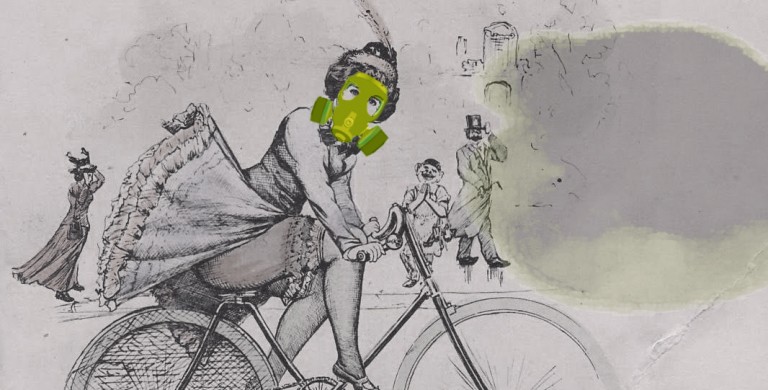On the Plan.Place blog, planner Jenny Koch describes how planners and bicyclists can make it easier to breathe on a bicycle, by reducing the risks posed by traffic-related air pollutants.

Inspired by her bicycle commute between DC and Northern Virginia, planner Jenny Koch explores, on the Plan.Place blog, why and how we should be taking air pollution into account when planning for bicycles. Those who choose to (always or sometimes) ride a bicycle rather than drive know that there can be many benefits for their mental and physical health, time efficiency (no need to look for parking!), and cost savings. But "if we are installing bicycle facilities to encourage healthy behavior and environmentally-sound decision-making, we shouldn’t ignore evidence that certain types of bicycle facilities are better for our health than others. […] People riding bicycles in lanes directly adjacent to vehicles are exposed to higher levels of traffic-related air pollution than those riding on separated lanes or paths. Yet pollution exposure does not directly influence how we plan and design bicycle facilities."
"Drivers are more exposed to airborne pollution than cyclists by a factor of 1.7-3.7, but elevated levels of particulates are of particular concern to people on bicycles because of their increased respiration and absorption rates compared with most other road users. [But just] because we know there are risks associated with riding a bicycle doesn’t mean that we should stop planning for (or riding) bicycles. Air quality and bicycles are already being tied together in many places, as cities recognize that the more that we exchange short automobile trips (which make up the bulk of urban trips) with non-motorized trips, the better our urban air quality and health would be. Now we just have to recognize that the relationship and impacts between bicycles and air quality go both ways."
Koch argues that while it may not be the most important factor in a planning process, "pollution from traffic should [at least] be given ‘factor’ status and be brought into the equation so that it can influence the process when warranted by the conditions." Suggested solutions range from the installation of separated lanes – particularly in heavy-traffic areas, or areas where air quality is already poor – to better outreach and information sharing for people riding bicycles.
FULL STORY: Breathe Easier: Six ways to reduce the impacts of air pollution on people riding bicycles

Analysis: Cybertruck Fatality Rate Far Exceeds That of Ford Pinto
The Tesla Cybertruck was recalled seven times last year.

National Parks Layoffs Will Cause Communities to Lose Billions
Thousands of essential park workers were laid off this week, just before the busy spring break season.

Retro-silient?: America’s First “Eco-burb,” The Woodlands Turns 50
A master-planned community north of Houston offers lessons on green infrastructure and resilient design, but falls short of its founder’s lofty affordability and walkability goals.

Test News Post 1
This is a summary

Analysis: Cybertruck Fatality Rate Far Exceeds That of Ford Pinto
The Tesla Cybertruck was recalled seven times last year.

Test News Headline 46
Test for the image on the front page.
Urban Design for Planners 1: Software Tools
This six-course series explores essential urban design concepts using open source software and equips planners with the tools they need to participate fully in the urban design process.
Planning for Universal Design
Learn the tools for implementing Universal Design in planning regulations.
EMC Planning Group, Inc.
Planetizen
Planetizen
Mpact (formerly Rail~Volution)
Great Falls Development Authority, Inc.
HUDs Office of Policy Development and Research
NYU Wagner Graduate School of Public Service

























